Assignment on Advanced Epidemiology
VerifiedAdded on 2022/08/22
|10
|2022
|23
AI Summary
Contribute Materials
Your contribution can guide someone’s learning journey. Share your
documents today.

Running head: ADVANCED EPIDEMIOLOGY
MASTERS OF PUBLIC HEALTH
COURSEWORK ASSESSMENT SUBMISSION
Course Name Advanced Epidemiology (MED5523)
Student ID no:
MASTERS OF PUBLIC HEALTH
COURSEWORK ASSESSMENT SUBMISSION
Course Name Advanced Epidemiology (MED5523)
Student ID no:
Secure Best Marks with AI Grader
Need help grading? Try our AI Grader for instant feedback on your assignments.

ADVANCED EPIDEMIOLOGY
Answers
1. The researchers aim at evaluating the impact on the mortality rates of the
cohort by the alcohol consumption patterns of the individuals and determine a correlation
between the pattern of alcohol consumption with that mortality due to stroke or coronary
heart diseases in the individuals.
The intended exposure that is identified in the study is alcohol consumption. The
researchers conduct a follow-up study for the working Scottish men for 21 years and collect
data on the alcohol consumption of the individuals during the 21 year period. Data collected
for this parameter fulfills the objective of the study, and hence alcohol consumption can be
the suited intended exposure for the sample study of Scottish men. However, the actual
exposure in the study was limited to the working-group of Scottish men, which is different
from the intended exposure, as the study aimed at evaluating the impact on mortality rate by
alcohol consumption for the whole population of Scotland.
Notwithstanding the planned exposure of alcohol utilization in Spanish men, the
researchers needed to assess other critical exposures which the sample populace was exposed
to during their 21 years follow up study and which impacted their wellbeing, particularly
prompting inconveniences of stroke and demise. One of these exposures that the scientists
needed to consider was smoking, which is the transcendent reason for respiratory and heart-
related complexities. The intended exposure was meant for the whole population, however,
the actual exposure was limited to the working-men population, thus excluding the women,
and non-working population. This will influence the generalisability of the research findings,
as the results from the study will be most suited for the working population of men only, who
have different drinking habit in comparison to the rest of the population. The research
findings will be not applicable to the young population and the difference in the intended and
Answers
1. The researchers aim at evaluating the impact on the mortality rates of the
cohort by the alcohol consumption patterns of the individuals and determine a correlation
between the pattern of alcohol consumption with that mortality due to stroke or coronary
heart diseases in the individuals.
The intended exposure that is identified in the study is alcohol consumption. The
researchers conduct a follow-up study for the working Scottish men for 21 years and collect
data on the alcohol consumption of the individuals during the 21 year period. Data collected
for this parameter fulfills the objective of the study, and hence alcohol consumption can be
the suited intended exposure for the sample study of Scottish men. However, the actual
exposure in the study was limited to the working-group of Scottish men, which is different
from the intended exposure, as the study aimed at evaluating the impact on mortality rate by
alcohol consumption for the whole population of Scotland.
Notwithstanding the planned exposure of alcohol utilization in Spanish men, the
researchers needed to assess other critical exposures which the sample populace was exposed
to during their 21 years follow up study and which impacted their wellbeing, particularly
prompting inconveniences of stroke and demise. One of these exposures that the scientists
needed to consider was smoking, which is the transcendent reason for respiratory and heart-
related complexities. The intended exposure was meant for the whole population, however,
the actual exposure was limited to the working-men population, thus excluding the women,
and non-working population. This will influence the generalisability of the research findings,
as the results from the study will be most suited for the working population of men only, who
have different drinking habit in comparison to the rest of the population. The research
findings will be not applicable to the young population and the difference in the intended and
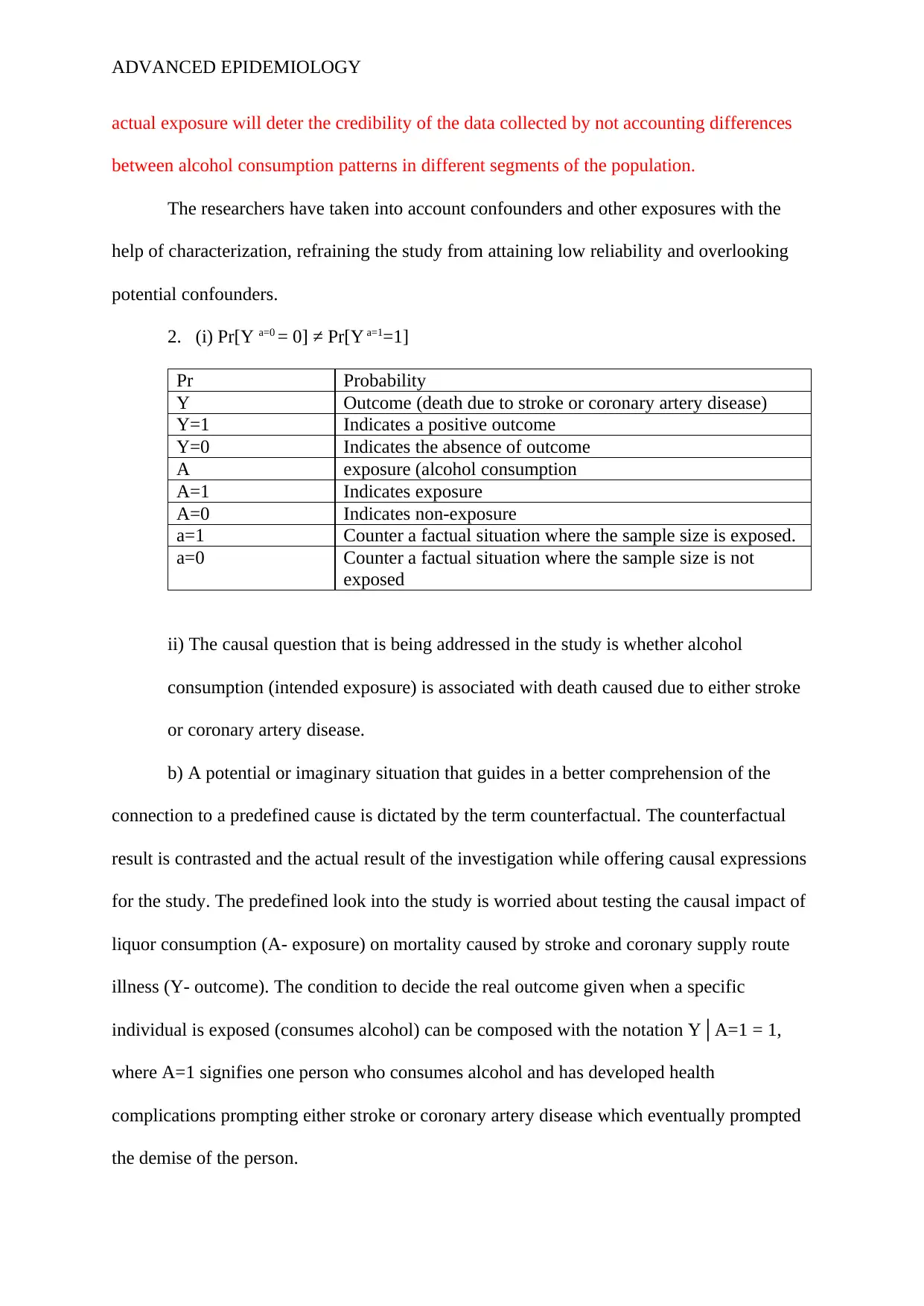
ADVANCED EPIDEMIOLOGY
actual exposure will deter the credibility of the data collected by not accounting differences
between alcohol consumption patterns in different segments of the population.
The researchers have taken into account confounders and other exposures with the
help of characterization, refraining the study from attaining low reliability and overlooking
potential confounders.
2. (i) Pr[Y a=0 = 0] ≠ Pr[Y a=1=1]
Pr Probability
Y Outcome (death due to stroke or coronary artery disease)
Y=1 Indicates a positive outcome
Y=0 Indicates the absence of outcome
A exposure (alcohol consumption
A=1 Indicates exposure
A=0 Indicates non-exposure
a=1 Counter a factual situation where the sample size is exposed.
a=0 Counter a factual situation where the sample size is not
exposed
ii) The causal question that is being addressed in the study is whether alcohol
consumption (intended exposure) is associated with death caused due to either stroke
or coronary artery disease.
b) A potential or imaginary situation that guides in a better comprehension of the
connection to a predefined cause is dictated by the term counterfactual. The counterfactual
result is contrasted and the actual result of the investigation while offering causal expressions
for the study. The predefined look into the study is worried about testing the causal impact of
liquor consumption (A- exposure) on mortality caused by stroke and coronary supply route
illness (Y- outcome). The condition to decide the real outcome given when a specific
individual is exposed (consumes alcohol) can be composed with the notation Y│A=1 = 1,
where A=1 signifies one person who consumes alcohol and has developed health
complications prompting either stroke or coronary artery disease which eventually prompted
the demise of the person.
actual exposure will deter the credibility of the data collected by not accounting differences
between alcohol consumption patterns in different segments of the population.
The researchers have taken into account confounders and other exposures with the
help of characterization, refraining the study from attaining low reliability and overlooking
potential confounders.
2. (i) Pr[Y a=0 = 0] ≠ Pr[Y a=1=1]
Pr Probability
Y Outcome (death due to stroke or coronary artery disease)
Y=1 Indicates a positive outcome
Y=0 Indicates the absence of outcome
A exposure (alcohol consumption
A=1 Indicates exposure
A=0 Indicates non-exposure
a=1 Counter a factual situation where the sample size is exposed.
a=0 Counter a factual situation where the sample size is not
exposed
ii) The causal question that is being addressed in the study is whether alcohol
consumption (intended exposure) is associated with death caused due to either stroke
or coronary artery disease.
b) A potential or imaginary situation that guides in a better comprehension of the
connection to a predefined cause is dictated by the term counterfactual. The counterfactual
result is contrasted and the actual result of the investigation while offering causal expressions
for the study. The predefined look into the study is worried about testing the causal impact of
liquor consumption (A- exposure) on mortality caused by stroke and coronary supply route
illness (Y- outcome). The condition to decide the real outcome given when a specific
individual is exposed (consumes alcohol) can be composed with the notation Y│A=1 = 1,
where A=1 signifies one person who consumes alcohol and has developed health
complications prompting either stroke or coronary artery disease which eventually prompted
the demise of the person.
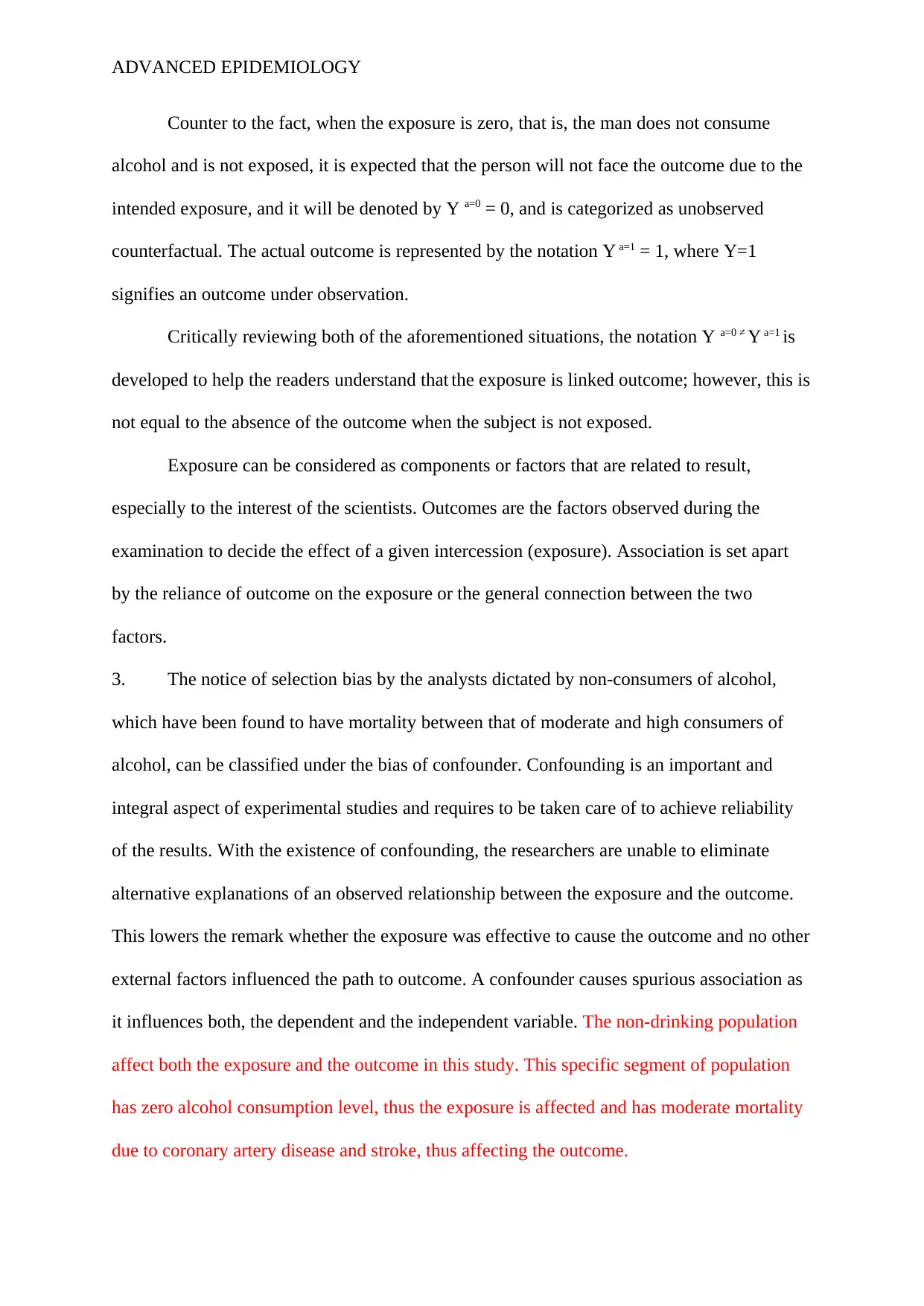
ADVANCED EPIDEMIOLOGY
Counter to the fact, when the exposure is zero, that is, the man does not consume
alcohol and is not exposed, it is expected that the person will not face the outcome due to the
intended exposure, and it will be denoted by Y a=0 = 0, and is categorized as unobserved
counterfactual. The actual outcome is represented by the notation Y a=1 = 1, where Y=1
signifies an outcome under observation.
Critically reviewing both of the aforementioned situations, the notation Y a=0 ≠ Y a=1 is
developed to help the readers understand that the exposure is linked outcome; however, this is
not equal to the absence of the outcome when the subject is not exposed.
Exposure can be considered as components or factors that are related to result,
especially to the interest of the scientists. Outcomes are the factors observed during the
examination to decide the effect of a given intercession (exposure). Association is set apart
by the reliance of outcome on the exposure or the general connection between the two
factors.
3. The notice of selection bias by the analysts dictated by non-consumers of alcohol,
which have been found to have mortality between that of moderate and high consumers of
alcohol, can be classified under the bias of confounder. Confounding is an important and
integral aspect of experimental studies and requires to be taken care of to achieve reliability
of the results. With the existence of confounding, the researchers are unable to eliminate
alternative explanations of an observed relationship between the exposure and the outcome.
This lowers the remark whether the exposure was effective to cause the outcome and no other
external factors influenced the path to outcome. A confounder causes spurious association as
it influences both, the dependent and the independent variable. The non-drinking population
affect both the exposure and the outcome in this study. This specific segment of population
has zero alcohol consumption level, thus the exposure is affected and has moderate mortality
due to coronary artery disease and stroke, thus affecting the outcome.
Counter to the fact, when the exposure is zero, that is, the man does not consume
alcohol and is not exposed, it is expected that the person will not face the outcome due to the
intended exposure, and it will be denoted by Y a=0 = 0, and is categorized as unobserved
counterfactual. The actual outcome is represented by the notation Y a=1 = 1, where Y=1
signifies an outcome under observation.
Critically reviewing both of the aforementioned situations, the notation Y a=0 ≠ Y a=1 is
developed to help the readers understand that the exposure is linked outcome; however, this is
not equal to the absence of the outcome when the subject is not exposed.
Exposure can be considered as components or factors that are related to result,
especially to the interest of the scientists. Outcomes are the factors observed during the
examination to decide the effect of a given intercession (exposure). Association is set apart
by the reliance of outcome on the exposure or the general connection between the two
factors.
3. The notice of selection bias by the analysts dictated by non-consumers of alcohol,
which have been found to have mortality between that of moderate and high consumers of
alcohol, can be classified under the bias of confounder. Confounding is an important and
integral aspect of experimental studies and requires to be taken care of to achieve reliability
of the results. With the existence of confounding, the researchers are unable to eliminate
alternative explanations of an observed relationship between the exposure and the outcome.
This lowers the remark whether the exposure was effective to cause the outcome and no other
external factors influenced the path to outcome. A confounder causes spurious association as
it influences both, the dependent and the independent variable. The non-drinking population
affect both the exposure and the outcome in this study. This specific segment of population
has zero alcohol consumption level, thus the exposure is affected and has moderate mortality
due to coronary artery disease and stroke, thus affecting the outcome.
Secure Best Marks with AI Grader
Need help grading? Try our AI Grader for instant feedback on your assignments.
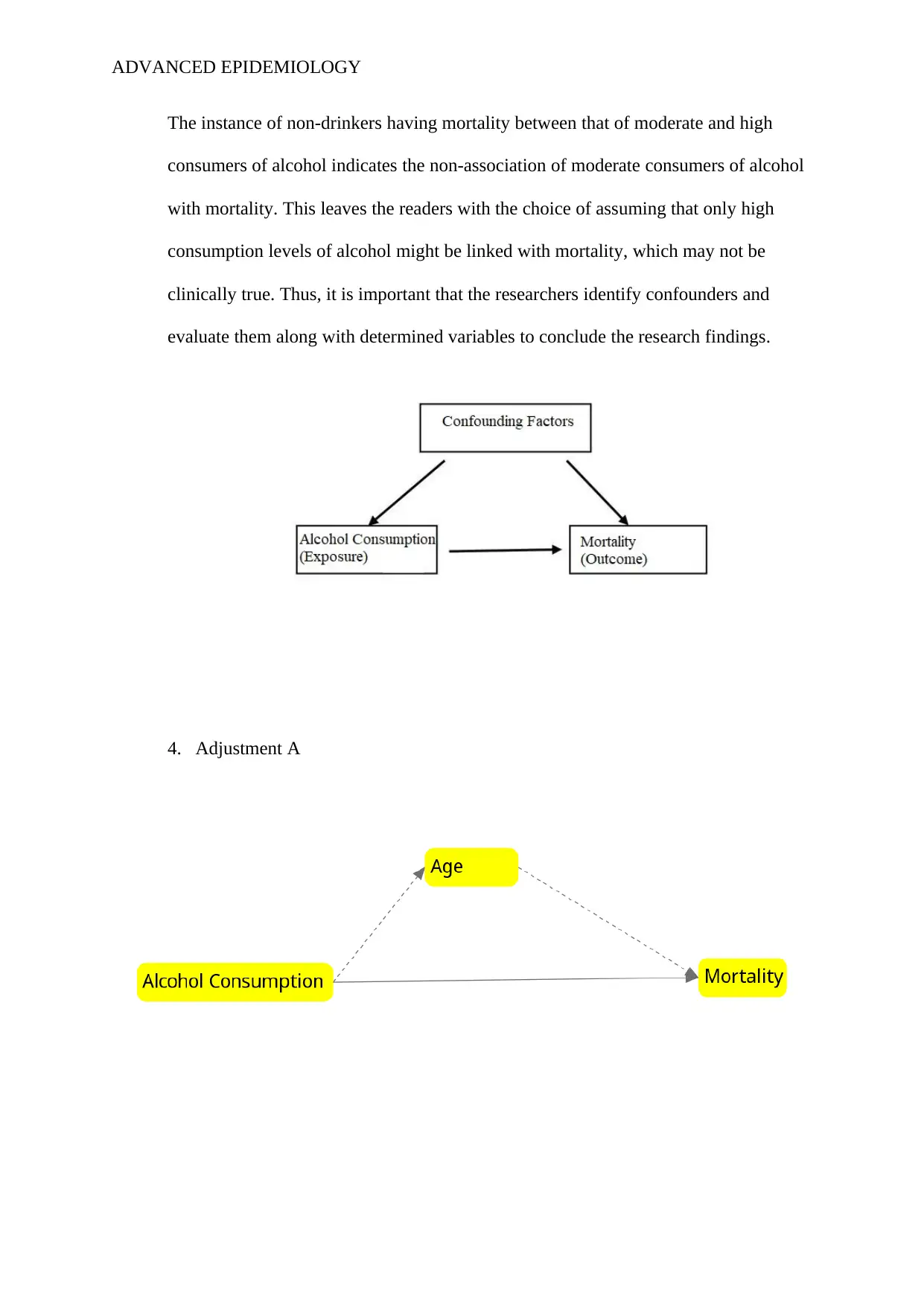
ADVANCED EPIDEMIOLOGY
The instance of non-drinkers having mortality between that of moderate and high
consumers of alcohol indicates the non-association of moderate consumers of alcohol
with mortality. This leaves the readers with the choice of assuming that only high
consumption levels of alcohol might be linked with mortality, which may not be
clinically true. Thus, it is important that the researchers identify confounders and
evaluate them along with determined variables to conclude the research findings.
4. Adjustment A
The instance of non-drinkers having mortality between that of moderate and high
consumers of alcohol indicates the non-association of moderate consumers of alcohol
with mortality. This leaves the readers with the choice of assuming that only high
consumption levels of alcohol might be linked with mortality, which may not be
clinically true. Thus, it is important that the researchers identify confounders and
evaluate them along with determined variables to conclude the research findings.
4. Adjustment A
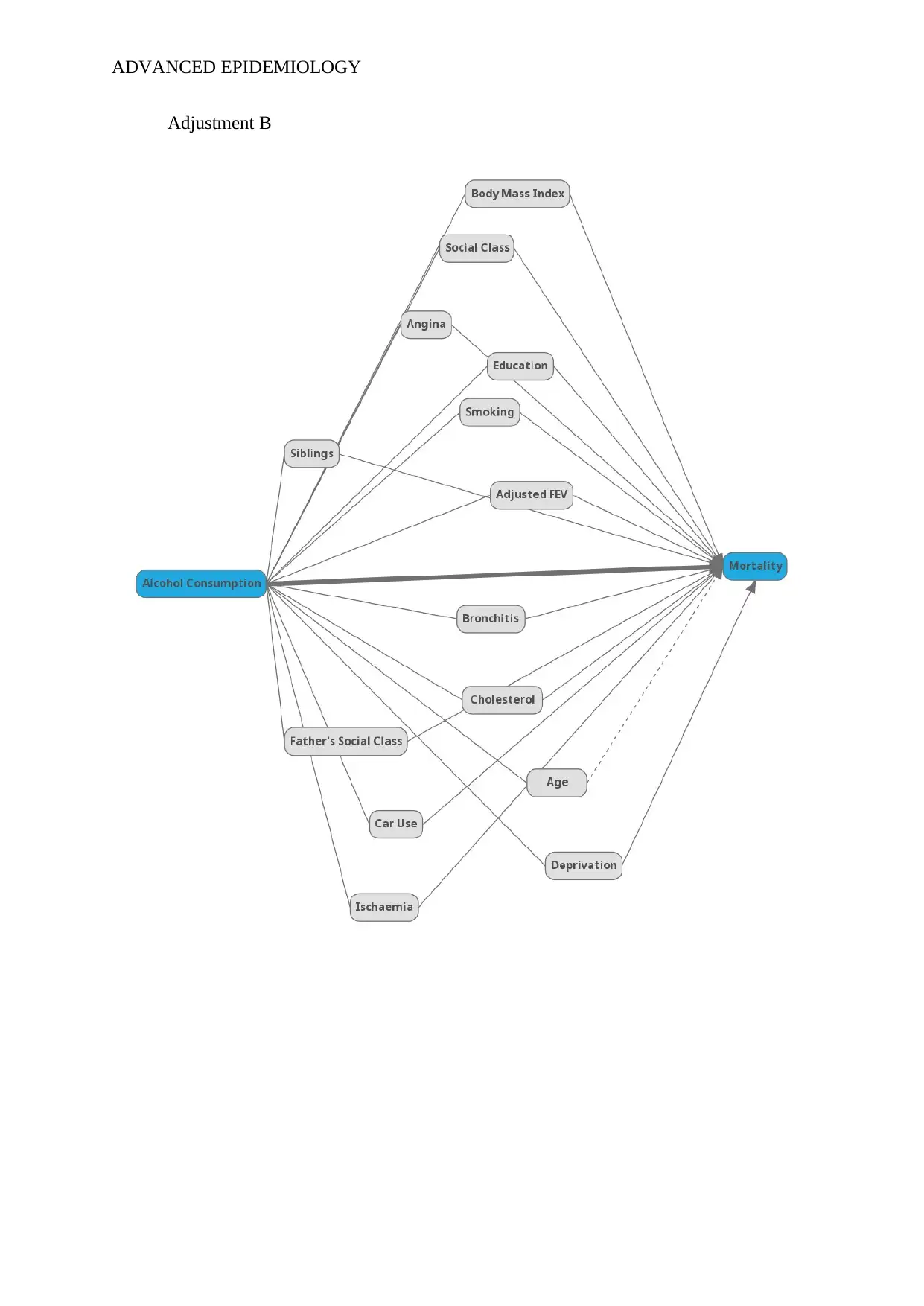
ADVANCED EPIDEMIOLOGY
Adjustment B
Adjustment B
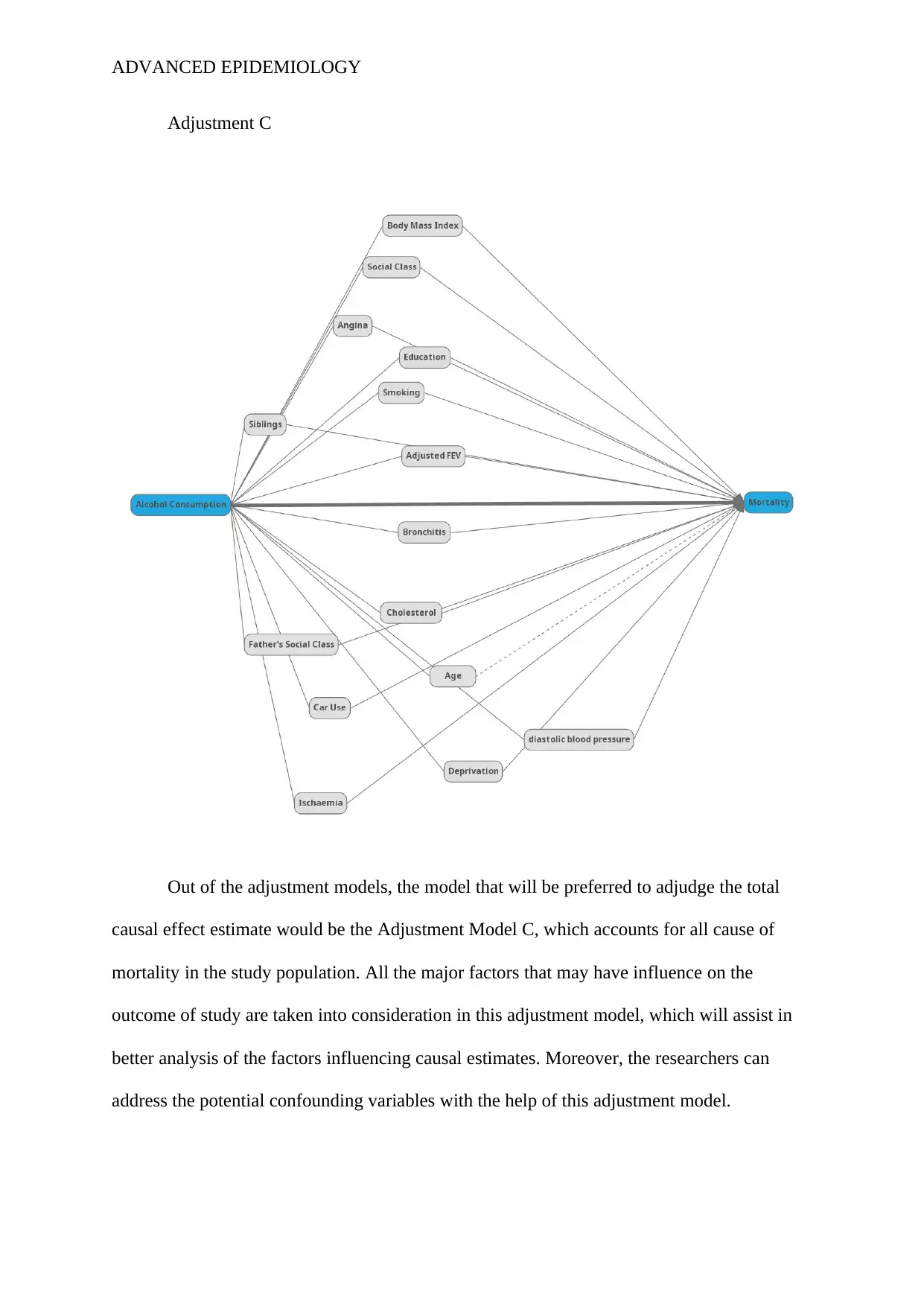
ADVANCED EPIDEMIOLOGY
Adjustment C
Out of the adjustment models, the model that will be preferred to adjudge the total
causal effect estimate would be the Adjustment Model C, which accounts for all cause of
mortality in the study population. All the major factors that may have influence on the
outcome of study are taken into consideration in this adjustment model, which will assist in
better analysis of the factors influencing causal estimates. Moreover, the researchers can
address the potential confounding variables with the help of this adjustment model.
Adjustment C
Out of the adjustment models, the model that will be preferred to adjudge the total
causal effect estimate would be the Adjustment Model C, which accounts for all cause of
mortality in the study population. All the major factors that may have influence on the
outcome of study are taken into consideration in this adjustment model, which will assist in
better analysis of the factors influencing causal estimates. Moreover, the researchers can
address the potential confounding variables with the help of this adjustment model.
Paraphrase This Document
Need a fresh take? Get an instant paraphrase of this document with our AI Paraphraser
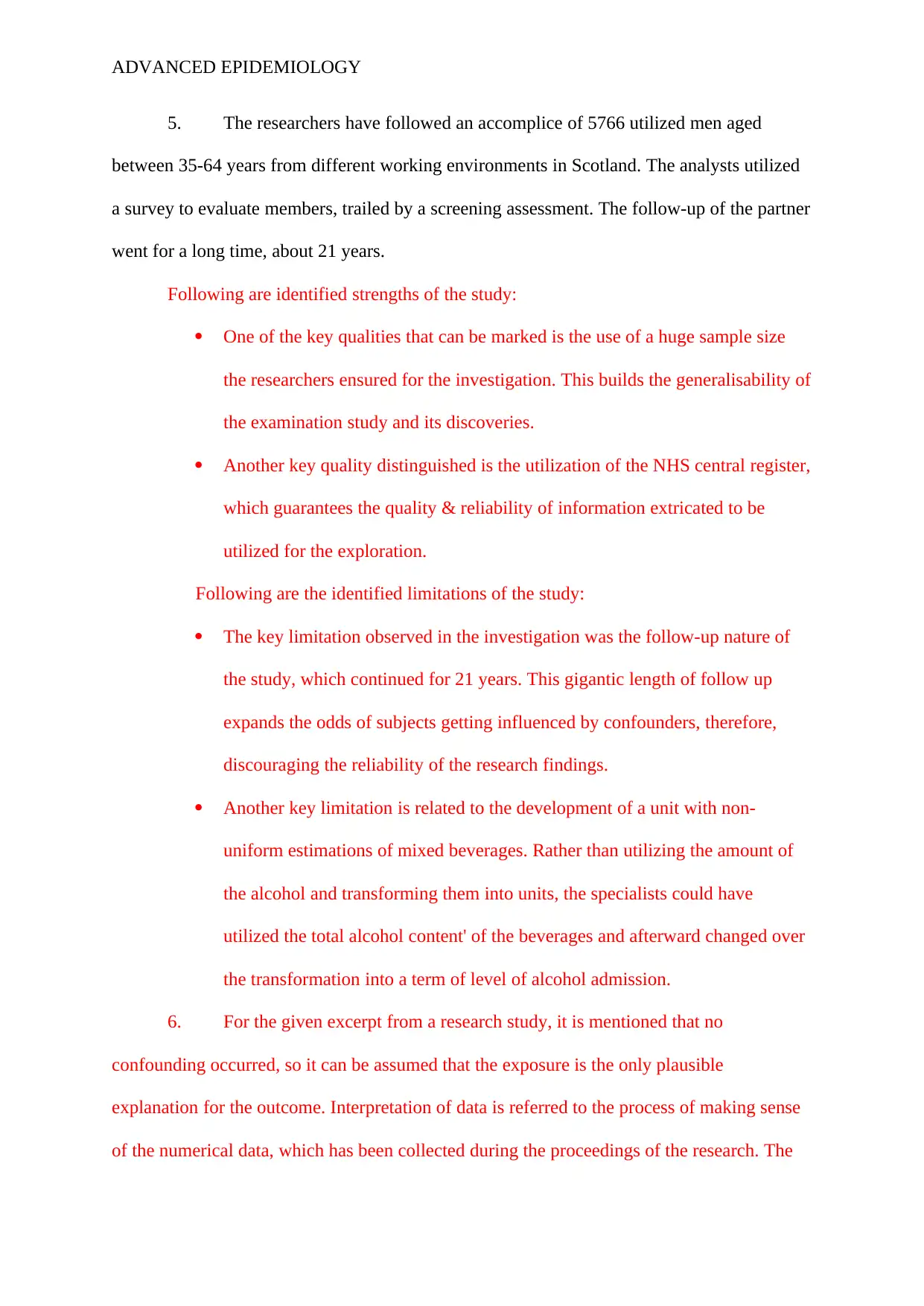
ADVANCED EPIDEMIOLOGY
5. The researchers have followed an accomplice of 5766 utilized men aged
between 35-64 years from different working environments in Scotland. The analysts utilized
a survey to evaluate members, trailed by a screening assessment. The follow-up of the partner
went for a long time, about 21 years.
Following are identified strengths of the study:
One of the key qualities that can be marked is the use of a huge sample size
the researchers ensured for the investigation. This builds the generalisability of
the examination study and its discoveries.
Another key quality distinguished is the utilization of the NHS central register,
which guarantees the quality & reliability of information extricated to be
utilized for the exploration.
Following are the identified limitations of the study:
The key limitation observed in the investigation was the follow-up nature of
the study, which continued for 21 years. This gigantic length of follow up
expands the odds of subjects getting influenced by confounders, therefore,
discouraging the reliability of the research findings.
Another key limitation is related to the development of a unit with non-
uniform estimations of mixed beverages. Rather than utilizing the amount of
the alcohol and transforming them into units, the specialists could have
utilized the total alcohol content' of the beverages and afterward changed over
the transformation into a term of level of alcohol admission.
6. For the given excerpt from a research study, it is mentioned that no
confounding occurred, so it can be assumed that the exposure is the only plausible
explanation for the outcome. Interpretation of data is referred to the process of making sense
of the numerical data, which has been collected during the proceedings of the research. The
5. The researchers have followed an accomplice of 5766 utilized men aged
between 35-64 years from different working environments in Scotland. The analysts utilized
a survey to evaluate members, trailed by a screening assessment. The follow-up of the partner
went for a long time, about 21 years.
Following are identified strengths of the study:
One of the key qualities that can be marked is the use of a huge sample size
the researchers ensured for the investigation. This builds the generalisability of
the examination study and its discoveries.
Another key quality distinguished is the utilization of the NHS central register,
which guarantees the quality & reliability of information extricated to be
utilized for the exploration.
Following are the identified limitations of the study:
The key limitation observed in the investigation was the follow-up nature of
the study, which continued for 21 years. This gigantic length of follow up
expands the odds of subjects getting influenced by confounders, therefore,
discouraging the reliability of the research findings.
Another key limitation is related to the development of a unit with non-
uniform estimations of mixed beverages. Rather than utilizing the amount of
the alcohol and transforming them into units, the specialists could have
utilized the total alcohol content' of the beverages and afterward changed over
the transformation into a term of level of alcohol admission.
6. For the given excerpt from a research study, it is mentioned that no
confounding occurred, so it can be assumed that the exposure is the only plausible
explanation for the outcome. Interpretation of data is referred to the process of making sense
of the numerical data, which has been collected during the proceedings of the research. The
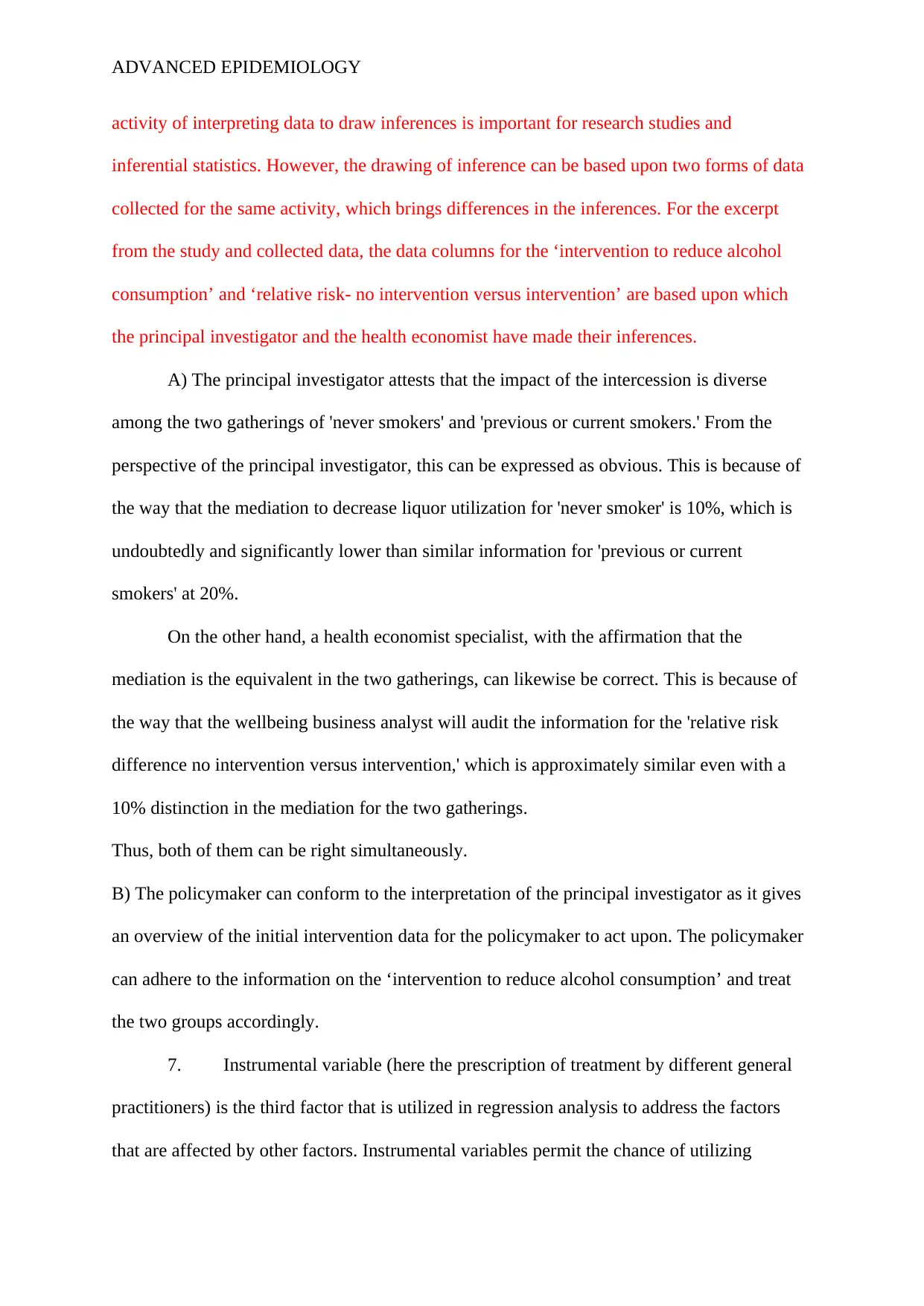
ADVANCED EPIDEMIOLOGY
activity of interpreting data to draw inferences is important for research studies and
inferential statistics. However, the drawing of inference can be based upon two forms of data
collected for the same activity, which brings differences in the inferences. For the excerpt
from the study and collected data, the data columns for the ‘intervention to reduce alcohol
consumption’ and ‘relative risk- no intervention versus intervention’ are based upon which
the principal investigator and the health economist have made their inferences.
A) The principal investigator attests that the impact of the intercession is diverse
among the two gatherings of 'never smokers' and 'previous or current smokers.' From the
perspective of the principal investigator, this can be expressed as obvious. This is because of
the way that the mediation to decrease liquor utilization for 'never smoker' is 10%, which is
undoubtedly and significantly lower than similar information for 'previous or current
smokers' at 20%.
On the other hand, a health economist specialist, with the affirmation that the
mediation is the equivalent in the two gatherings, can likewise be correct. This is because of
the way that the wellbeing business analyst will audit the information for the 'relative risk
difference no intervention versus intervention,' which is approximately similar even with a
10% distinction in the mediation for the two gatherings.
Thus, both of them can be right simultaneously.
B) The policymaker can conform to the interpretation of the principal investigator as it gives
an overview of the initial intervention data for the policymaker to act upon. The policymaker
can adhere to the information on the ‘intervention to reduce alcohol consumption’ and treat
the two groups accordingly.
7. Instrumental variable (here the prescription of treatment by different general
practitioners) is the third factor that is utilized in regression analysis to address the factors
that are affected by other factors. Instrumental variables permit the chance of utilizing
activity of interpreting data to draw inferences is important for research studies and
inferential statistics. However, the drawing of inference can be based upon two forms of data
collected for the same activity, which brings differences in the inferences. For the excerpt
from the study and collected data, the data columns for the ‘intervention to reduce alcohol
consumption’ and ‘relative risk- no intervention versus intervention’ are based upon which
the principal investigator and the health economist have made their inferences.
A) The principal investigator attests that the impact of the intercession is diverse
among the two gatherings of 'never smokers' and 'previous or current smokers.' From the
perspective of the principal investigator, this can be expressed as obvious. This is because of
the way that the mediation to decrease liquor utilization for 'never smoker' is 10%, which is
undoubtedly and significantly lower than similar information for 'previous or current
smokers' at 20%.
On the other hand, a health economist specialist, with the affirmation that the
mediation is the equivalent in the two gatherings, can likewise be correct. This is because of
the way that the wellbeing business analyst will audit the information for the 'relative risk
difference no intervention versus intervention,' which is approximately similar even with a
10% distinction in the mediation for the two gatherings.
Thus, both of them can be right simultaneously.
B) The policymaker can conform to the interpretation of the principal investigator as it gives
an overview of the initial intervention data for the policymaker to act upon. The policymaker
can adhere to the information on the ‘intervention to reduce alcohol consumption’ and treat
the two groups accordingly.
7. Instrumental variable (here the prescription of treatment by different general
practitioners) is the third factor that is utilized in regression analysis to address the factors
that are affected by other factors. Instrumental variables permit the chance of utilizing
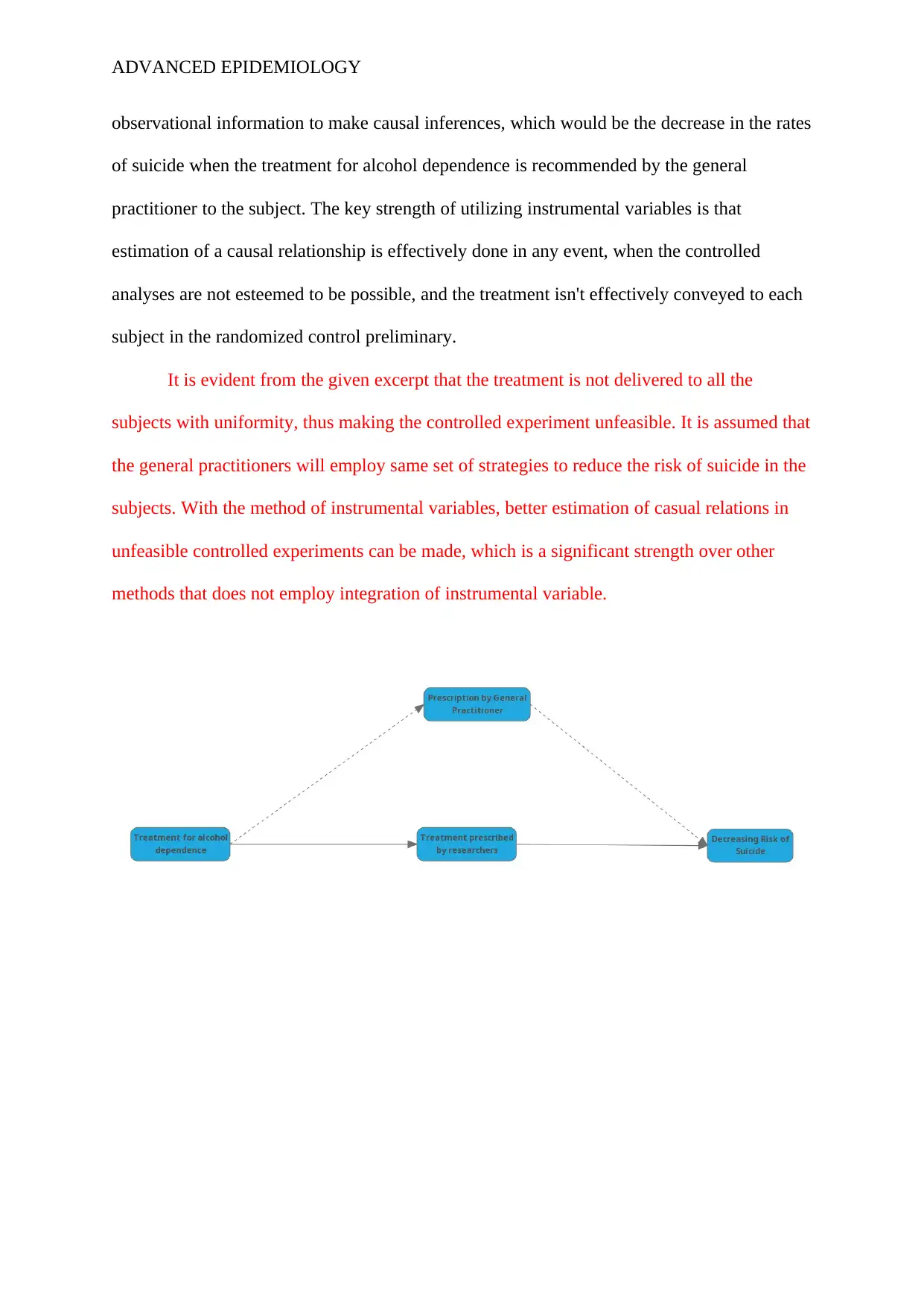
ADVANCED EPIDEMIOLOGY
observational information to make causal inferences, which would be the decrease in the rates
of suicide when the treatment for alcohol dependence is recommended by the general
practitioner to the subject. The key strength of utilizing instrumental variables is that
estimation of a causal relationship is effectively done in any event, when the controlled
analyses are not esteemed to be possible, and the treatment isn't effectively conveyed to each
subject in the randomized control preliminary.
It is evident from the given excerpt that the treatment is not delivered to all the
subjects with uniformity, thus making the controlled experiment unfeasible. It is assumed that
the general practitioners will employ same set of strategies to reduce the risk of suicide in the
subjects. With the method of instrumental variables, better estimation of casual relations in
unfeasible controlled experiments can be made, which is a significant strength over other
methods that does not employ integration of instrumental variable.
observational information to make causal inferences, which would be the decrease in the rates
of suicide when the treatment for alcohol dependence is recommended by the general
practitioner to the subject. The key strength of utilizing instrumental variables is that
estimation of a causal relationship is effectively done in any event, when the controlled
analyses are not esteemed to be possible, and the treatment isn't effectively conveyed to each
subject in the randomized control preliminary.
It is evident from the given excerpt that the treatment is not delivered to all the
subjects with uniformity, thus making the controlled experiment unfeasible. It is assumed that
the general practitioners will employ same set of strategies to reduce the risk of suicide in the
subjects. With the method of instrumental variables, better estimation of casual relations in
unfeasible controlled experiments can be made, which is a significant strength over other
methods that does not employ integration of instrumental variable.
1 out of 10
Your All-in-One AI-Powered Toolkit for Academic Success.
+13062052269
info@desklib.com
Available 24*7 on WhatsApp / Email
![[object Object]](/_next/static/media/star-bottom.7253800d.svg)
Unlock your academic potential
© 2024 | Zucol Services PVT LTD | All rights reserved.